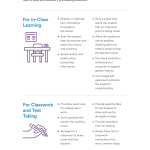Accommodations for Auditory Processing: Breaking Down Barriers

Hey there, folks. If you or someone you know is dealing with auditory processing issues, you’re in the right place. In this article, we’re gonna dive into the world of accommodations for auditory processing and explore what it takes to break down those barriers.
What is Auditory Processing?
Before we jump into accommodations, let’s get a handle on what auditory processing is all about. Auditory processing refers to the way our brains process sound. It’s like our brain’s ability to filter out background noise, make sense of conversations, and understand the nuances of language.
Some people have a tougher time with auditory processing due to various conditions like ADHD, autism, or sensory processing disorder. It’s like their brain gets overwhelmed by all the sounds, making it hard to focus and understand.
Accommodations for Auditory Processing: What You Need to Know
Accommodations for auditory processing are modifications or adjustments made to help individuals with auditory processing issues. The goal is to provide an environment that’s conducive to learning, working, or just general well-being.
Here are some common accommodations for auditory processing:
1. Noise-Canceling Headphones
Noise-canceling headphones are a game-changer for those with auditory processing issues. They help block out background noise, allowing individuals to focus on the sounds they need to hear.
2. FM Systems
FM systems are like personalized sound systems. They help improve sound quality, making it easier for individuals to hear and understand conversations.
3. Sound Therapy
Sound therapy is a type of therapy that uses sound to retrain the brain. It can help improve auditory processing skills, like filtering out background noise.
4. Adapted Learning Environments
Adapted learning environments are designed to minimize distractions and promote learning. This can include strategies like seating near the front of the classroom or using visual aids.
Accommodations for Auditory Processing in the Classroom
In the classroom, accommodations for auditory processing can make a huge difference. Here are some strategies teachers can use:
1. Preferential Seating
Preferential seating means seating the individual near the front of the classroom, away from distractions.
2. Visual Aids
Visual aids like diagrams, charts, and pictures can help reinforce learning and reduce reliance on auditory cues.
3. Note-Taking Assistance
Note-taking assistance can include providing notes in advance or using a note-taker.
4. Breakout Spaces
Breakout spaces are designated areas for individuals to take a break from the main classroom. This can help reduce overwhelm.
Accommodations for Auditory Processing in the Workplace
In the workplace, accommodations for auditory processing can improve job performance and overall well-being. Here are some strategies:
1. Noise-Reducing Materials
Noise-reducing materials like acoustic panels can help minimize background noise.
2. Flexible Work Arrangements
Flexible work arrangements like telecommuting or flexible hours can help individuals avoid overwhelming situations.
3. Technology Adaptations
Technology adaptations like speech-to-text software can help improve communication.
4. Employee Support
Employee support like mental health resources or employee assistance programs can help individuals cope with auditory processing-related stress.
Creating a Supportive Environment: Tips and Tricks
Creating a supportive environment for individuals with auditory processing issues requires effort and empathy. Here are some tips and tricks:
1. Be Patient
Be patient with individuals who struggle with auditory processing. It’s not something they can control.
2. Use Visual Cues
Use visual cues like hand gestures or visual aids to support learning and communication.
3. Minimize Distractions
Minimize distractions by reducing background noise or using noise-canceling headphones.
4. Encourage Self-Advocacy
Encourage individuals to self-advocate and communicate their needs.
Accommodations for Auditory Processing: Breaking Down Barriers
In conclusion, accommodations for auditory processing are essential for breaking down barriers. By providing the right environment, tools, and support, individuals with auditory processing issues can thrive.
Accommodations for auditory processing are not a one-size-fits-all solution. Each individual requires a unique set of modifications to ensure success.
Accommodations for Auditory Processing: The Bottom Line
Accommodations for auditory processing are a must-have for individuals who struggle with auditory processing. By making simple modifications, we can create a more inclusive and supportive environment.
Accommodations for auditory processing are not a luxury; they’re a necessity.
Accommodations for Auditory Processing: Final Thoughts
In the end, accommodations for auditory processing come down to empathy and understanding. By being open-minded and supportive, we can create a world that’s more inclusive and accessible for all.
Accommodations for auditory processing: breaking down barriers one step at a time.
<